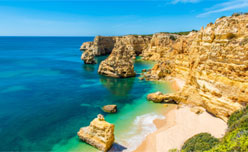Experience the wonderful Algarve weather in different seasons
The Benagil cave, an unusual rock at the cliff coast, bathed in the turquoise ocean, is one of the most photographed attractions of the Algarve, the southernmost region of Portugal.
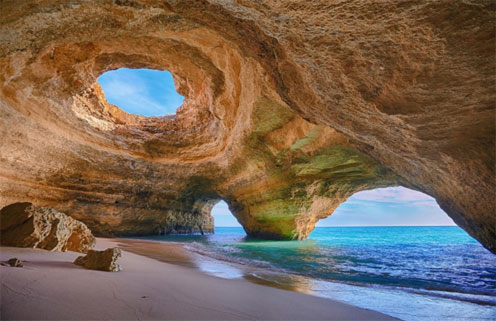
This extraordinary creation of nature is situated halfway between Portimão and Albufeira.
All the southern Portuguese coast, however, abounds in places of extraordinary beauty: endless beaches with soft and white sand, dramatic ragged cliffs and viewpoints offering panoramic views of the Atlantic.
Perfect weather, blue sky and over 3000 hours of sunshine registered in the Algarve throughout the year add to the allure of the scenery.
The mild climate of the region attracts the sun and heat seeking tourists, especially from the northern Europe and makes it a practically year-round destination. Find out, below, what weather to expect in the Algarve during different seasons of the year.
Please mind that the climate varies considerably along the 160 km of the Algarve coast; different temperatures are to be expected at the eastern section of the region, right by the border with Spain, sheltered by the landmass of the Iberian Peninsula and the westernmost area of Sagres, exposed from two sides to the Atlantic Ocean, and by such, windier and cooler.
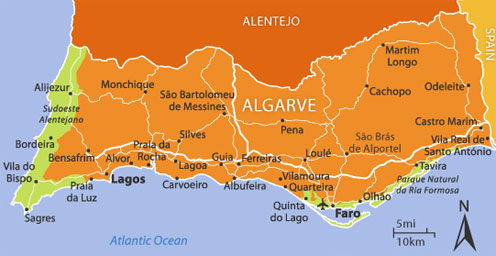
The Algarve overlaps the District of Faro, one of the 18 districts (administrative subdivisions) in Portugal.
Below, we focus on the central part of the region, attracting the largest number of tourists. The meteorological data below refers mainly to Faro, the capital of the region.
Summer in the Algarve – heat from June to September
The summer season in the south of the Algarve lasts for a very long time and often, if it wasn’t for the calendar to remind of the time of the year, it would be impossible to say for sure when the summer begins and when it ends.
Temperatures above 25 degrees are felt in Algarve from around mid-May. In June they are guaranteed. The average temperatures in July and August are of around 30 degrees and above. The difference between warm May in Algarve and, for example, July is felt mainly in the morning and at night.
In typical vacation months, like in July and August, the Algarve weather invites to stay outdoors; mornings and evenings are warm. When visiting Faro, Portimão or Lagos in May or September, however, make sure to have with you warmer outerwear. Despite the heat during daytime, the temperature will drop quickly as soon as the sun sets.
Rain in southern Portugal during the summer is a rare event; it is highly unlikely it should affect your July or August Algarve holidays.
Many tourists, who are familiar with the conditions in other popular tourist destinations of Southern Europe, are disappointed by the water temperature in Algarve. However, it should be remembered, that the local beaches are surrounded by the Atlantic, not the Mediterranean Sea and water temperature, even in the hottest periods does not exceed 21-22 degrees Celsius. Warmer water can be expected in the eastern part of the Algarve; the temperature of the ocean drops while you are approaching the west coast. On the stretch between Lagos and Sagres, the beaches are windier and the ocean, rougher, with stronger waves.
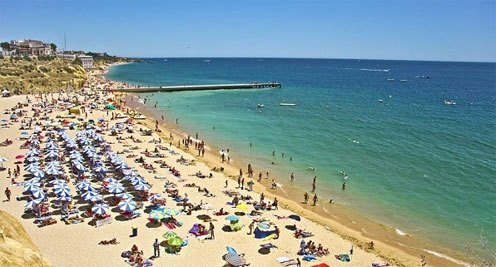
Beach in Albufeira, west from Faro, one of the most popular on this stretch of the Algarve coast.
A long and warm autumn in Algarve
Summer in southern Portugal almost unnoticeably turns into an unusually warm and mild autumn. In September, Faro still has summer temperatures, around 25 degrees Celsius on average during the day. The first sign of the arriving autumn is the increasing probability of rain. On average, it rains during 10-12 days per month.
Temperatures above 20 degrees Celsius are recorded during most of October. In November, the average daytime temperature in Faro is 15 degrees at midday, but with a clear sky (what remains clear for most of the year in the Algarve), it can easily rise to above 20 degrees.
A great advantage of autumn holidays in the Algarve, apart from slightly lower prices and lower number of tourists is, without a doubt, warm ocean; in September as warm as in August, at around 21-22 degrees Celsius. Despite the fact that in October the water temperature drops to 19 degrees, it is still possible to bathe in comfortable conditions.
Algarve in winter
In wintertime, Portugal attracts a slightly different type of tourists than in summer. Winter visitors are more focused on the cultural sights and the rich historic heritage of Portugal than on the beach holiday. Even in the Algarve, the warmest region of the country, swimming in the sea in December, January and February is an attraction only for the most courageous. The water temperature varies between 13 and 15 degrees Celsius at this time.
When it comes to the air temperature, the coldest month is January, during which the average temperature is 12 degrees. At midday the temperature often increases to 18-20 degrees, but the days are much shorter; in December and January you can count on only about 5 hours of sunshine.
Winter in the Algarve can be quite windy, especially in the western part, as well as rainy. December is the wettest month, with an average of 23 rainy days. It is, thus, the least popular month for holiday in the Algarve. It may disappoint those looking for a quick injection of energy, warmth and sunshine to survive the grim northern European winter.
Check current Faro weather conditions.
The chance of rain decreases considerably in February, when the days also become longer and sunnier.
Almond blossom in Algarve is one of the most recognizable signs of the soon-to-arrive spring.
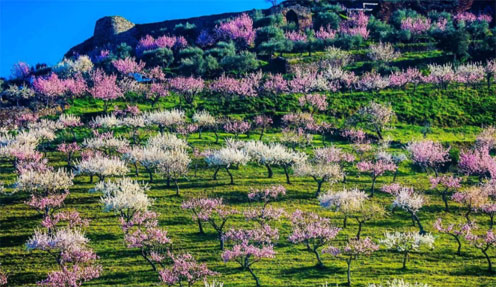
Algarve welcomes spring covered in white and pink flowers of the almond trees blossom.
Spring in the southern Portugal
The beaches in the Algarve become busy again starting from early March. The water is quite cool (about 15-17 degrees), however, the maximum temperatures increase quickly during the day and the days get longer.
Reduced chance of rain makes spring a great time to discover Algarve by car.
Pleasantly warm, but not yet hot days, encourage to make frequent stops at viewpoints and local towns and villages, and the roads are not busy. It is also easier to find accommodation, even without booking in advance, as hotels, guest houses or also guest rooms are waiting for the summer ‘invasion’ of tourists. The prices are also much lower than in July and August.

